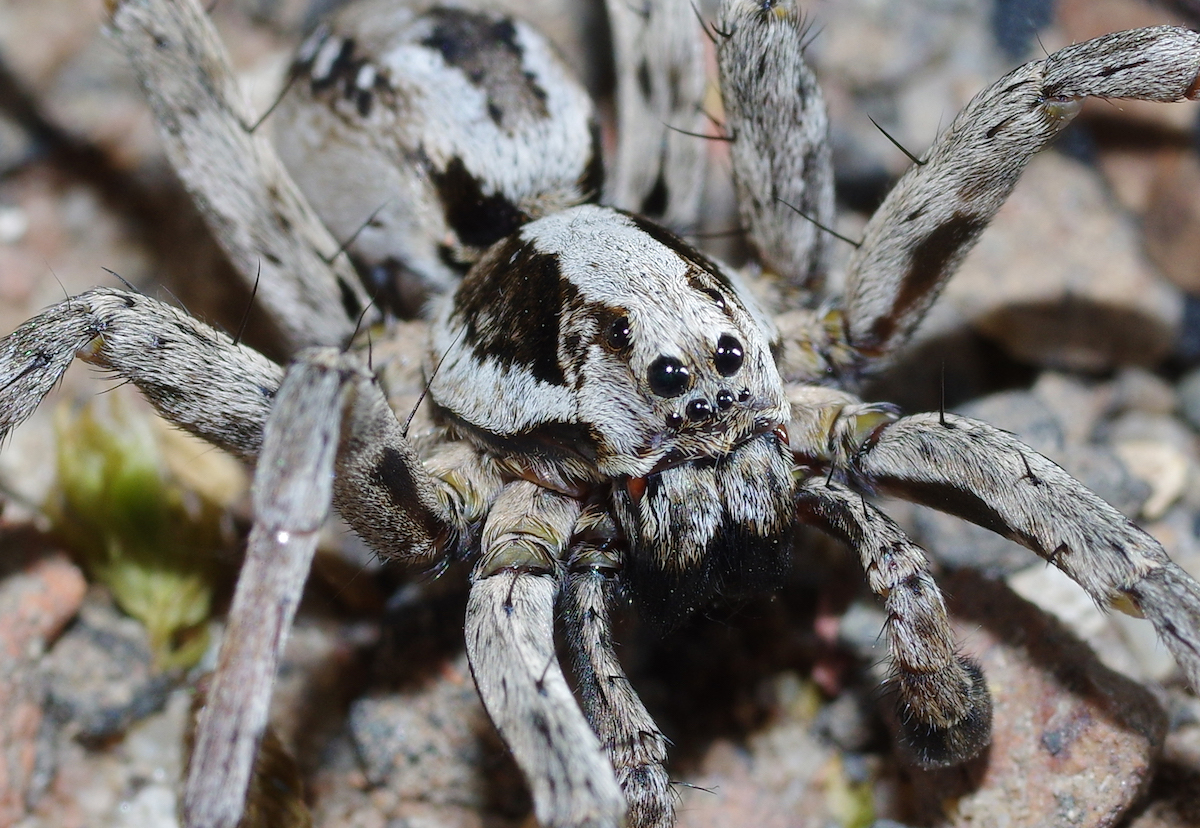 Abraham Lincoln
If given the truth, the people can be depended upon to meet any national crisis...
Abraham Lincoln
If given the truth, the people can be depended upon to meet any national crisis...
 Guildford news...
for Guildford people, brought to you by Guildford reporters - Guildford's own news service
Guildford news...
for Guildford people, brought to you by Guildford reporters - Guildford's own news service
Giant Hunting Spiders Once Feared Extinct Discovered on Surrey MoD Site
Published on: 31 Oct, 2020
Updated on: 3 Nov, 2020
After more than 25 years without a sighting, some of Britain’s largest and most endangered spiders have been rediscovered on a Ministry of Defence (MoD) training area in Surrey.
Surrey Wildlife Trust had the great fox-spider red-listed as “Critically Endangered” and feared extinct in the UK. They had been found at only three sites, two in Dorset and the other in Surrey, but hadn’t been seen since the early 1990s. Surrey Wildlife would not say where in the county the army training area is located.
Great fox-spiders do not spin webs to trap prey, nor will you ever find them lurking in your shower. They are ground-dwelling and largely nocturnal, but Mike Waite, spider enthusiast at the Trust, had never given up hope of finding the monsters, spending many night hours searching with a torch over the past two years.
Finally, he discovered some unidentifiable immature spiderlings, on MoD land managed by the Amphibian and Reptile Conservation Trust, then at last, several mature males and one female great fox-spider, which was 55mm or just more than two inches in diameter, including its hairy, spiny legs.
With excellent eyesight, camouflage and speed, the great fox-spider Alopecosa fabrilis is among the largest of the wolf-spider Lycosidae family of spiders. An opportunistic predator which hunts at night it is named for its wolf-like habit of chasing down its prey, across sandy terrain, over gravel and rocks before pouncing and capturing insects on the run.
Not only incredibly agile and fast-running, great fox-spiders have excellent eyesight with wrap-around vision provided by eight black eyes on its head, or cephalothorax. Two large eyes glint from the top of the head; two large eyes stare out the front; and four smaller eyes form a row just above the spider’s mouth.
Great Fox-Spiders immobilise their prey, including insects such as beetles, ants and smaller spiders, by injecting them with venom, which liquifies the insect’s internal organs. The spider feasts on its catch using its strong, fang-bearing front appendages called chelicerae.
For shelter, the great fox-spiders dig burrows or holes under rocks and logs and make a silk-lined burrow as a retreat for the winter. Mr Waite now plans to continue his study to gauge the size of the population.
“The Great Fox-Spider has not been seen since 1993,” he said. “The spider is at the very edge of its range in the UK, which accounts for its super-rarity here.
“This formidable-looking creature is an impressive beast, perfectly camouflaged and also largely nocturnal, and for all its size it has been remarkably elusive.
“Naturally, I am over-the-moon to have finally proved the continued existence of the great fox-spider in the UK. Although I’ve always held a latent interest in spiders, as a bona-fide arachnologist, I am still a relative newbie, so I’m doubly pleased to have made this important contribution to our scientific knowledge.”
Naturalist Nick Baker, TV presenter and president of the British Arachnological Society, said: “The prefix ‘great’ doesn’t seem to do it justice, maybe it should be the fabulous, or fantastic fox-spider. Even if the back story of its rarity and its rediscovery wasn’t taken into count, this spider is mega.
“It’s about as handsome as a spider gets, it’s big and now it’s officially a member of the British fauna again. The rediscovery of the great fox-spider is indeed the most exciting thing to happen in wildlife circles for quite some time. Glad it’s in safe hands.”
The MoD’s Rich Lowey said: “Many people are unaware of the size and diversity of the Defence estate and its tremendous wildlife richness.
“It has generally been protected from agricultural intensification and urban development, so it now provides a vital sanctuary for many of the country’s most rare and endangered species and habitats.
 “We are proud to hear the great fox-spider has survived because of the MoD’s commitment and enthusiasm to have positive and active conservation management on the Estate and close integrated working with ARC, Surrey Wildlife Trust and MOD Conservation Groups.”
“We are proud to hear the great fox-spider has survived because of the MoD’s commitment and enthusiasm to have positive and active conservation management on the Estate and close integrated working with ARC, Surrey Wildlife Trust and MOD Conservation Groups.”
Rob Free, Weald Reserves manager, Amphibian and Reptile Conservation (ARC), said: “The discovery of the great fox-spider shows how amazing the MoD heathland is, not just for spiders, but also for sand lizard, smooth snake, Dartford warbler, nightjar, silver-studded blue butterfly and marsh clubmoss.
“The spider’s rediscovery is a wonderful exoneration of all the incredibly hard work put in by MoD staff, conservation group members, ARC staff and volunteers.”
ARC has managed key parts of the site since 1974, with particular emphasis on preventing the endangered sand lizard from extinction, and as the MoD’s conservation partner, ARC has been managing much of the open heathland on the site since January 2019.
The MoD site is recognised as being nationally important for its populations of rare bird, reptile and invertebrate species.
For further information or to support Surrey Wildlife Trust visit www.surreywildlifetrust.org
Responses to Giant Hunting Spiders Once Feared Extinct Discovered on Surrey MoD Site
Leave a Comment Cancel reply
Please see our comments policy. All comments are moderated and may take time to appear. Full names, or at least initial and surname, must be given.Recent Articles
- Pedestrian Seriously Injured On Farnham Bypass – Police Appeal For Witnesses
- New Housing Planned To Replace Stables On Edge Of Wood Street Village
- Debt Charity’s New Report on State of Poverty in the South East and Help Available for People
- Local Government Reorganisation ‘A Great Opportunity To Start from Scratch’
- Notice: Poetry Competition – Enter by November 8
- Community Survey Planned To Discuss Future of the Troubled Electric Theatre
- 2025 Services of Remembrance to Honour our War Dead
- No Promise of A Mayor for Surrey
- Letter: This Decision Is an Outrageous Stitch-up
- The Spooky Hotel That Inspired The Winning Entry In Our Short Story Competition



Recent Comments
- RWL Davies on No Promise of A Mayor for Surrey
- John S Green on ‘Disaster in the Making’: Residents React with Anger and Distrust
- Amari Hawthorne-Bailey on Memories Of Queen Elizabeth Barracks And The Women’s Royal Army Corps
- Patrick Bray on It’s Two Unitaries for Surrey – SoS Says It Is Best Option for Financial Sustainability
- Mary English on Electric Theatre In Crisis As Financial Pressures Hit – Annual Loss of Over £250k
- Jackie Montague on Dragon Review: 2:22 A Ghost Story – Yvonne Arnaud Theatre
Search in Site
Media Gallery
Cllr Townsend on Waverley’s CIL Issue
August 27, 2025 / Comments Off on Cllr Townsend on Waverley’s CIL Issue / Read MoreMP Zöe Franklin Reviews Topical Issues
August 27, 2025 / Comments Off on MP Zöe Franklin Reviews Topical Issues / Read MoreMP Hopes Thames Water Fine Will Be ‘Final Nail in Its Coffin’
August 27, 2025 / Comments Off on MP Hopes Thames Water Fine Will Be ‘Final Nail in Its Coffin’ / Read MoreNew Guildford Mayor Howard Smith
August 27, 2025 / Comments Off on New Guildford Mayor Howard Smith / Read MoreA New Scene for a Guildford Street
August 27, 2025 / Comments Off on A New Scene for a Guildford Street / Read MoreDragon Interview: Sir Jeremy Hunt MP on His Knighthood and Some Local Issues
August 27, 2025 / Comments Off on Dragon Interview: Sir Jeremy Hunt MP on His Knighthood and Some Local Issues / Read MoreDragon Interview: Paul Follows Admits He Should Not Have Used the Word ‘Skewed’
August 27, 2025 / Comments Off on Dragon Interview: Paul Follows Admits He Should Not Have Used the Word ‘Skewed’ / Read MoreDragon Interview: Will Forster MP On His Recent Visit to Ukraine
August 27, 2025 / No Comment / Read MoreDragon Interview: Fiona Davidson on the ‘Devolution’ Proposals for Surrey
August 27, 2025 / No Comment / Read More















Harry Eve
November 1, 2020 at 9:07 pm
What a find!
It is great to have such uplifting news in the midst of the destruction currently planned for our local countryside.